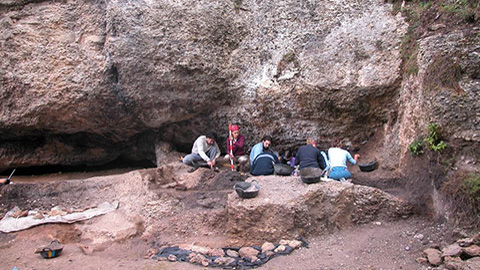Iberian Peninsula, last refuge of the European lineage surviving the Ice Age

15/03/2019
At the end of the Ice Age some 20,000 years ago, the Iberian Peninsula was not only a refuge conserving a diversity of birds and plants which disappeared in other regions of northern Europe. It also conserved the genetic diversity of the human populations existing at that time. This is revealed in a recent study led by the Max Planck Institute with the involvement of the Universitat Autònoma de Barcelona (UAB), which demonstrates the survival of two oldest Palaeolithic lineages found in the last hunter-gatherer societies and the first Neolithic populations found in the peninsula.
The research, published in Current Biology, analyses the genome of the last hunter-gatherers of the end of the Ice Age and of Neolithic individuals living in the peninsula some 13,000 to 6,000 years ago. A total of 11 individuals, with the oldest two having been found at the slope of Balma Guilanyà (Lleida, 12,000 years), were being studied by a team of researchers from the Centre for the Study of Prehistoric Archaeological Heritage (CEPAP-UAB). The study focused once again on the individual of the El Mirón Cave (Cantabria, 19,000 years) and incorporates genetic data spanning from the Palaeolithic to the Middle Neolithic published in Europe.
Previous studies pointed to the fact that the end of the Ice Age was a critical period for human populations. Only two genetic lineages from the Upper Palaeolithic had surviced in western and northern Europe. In the first, the individuals were associated with the Magdalenian chrono-culture period (20,000-15,000 years), the oldest representation of which is the El Mirón. The other lineage is related to the Epigravettian culture (15,000-13,000 years), with the oldest individual being discovered at the Villabruna site in Italy.
After a period of climate improvement occurring some 14,500 years ago, the Magadalenian lineage disappered and was replaced by that of the Villabruna societies - known from then on as the Western Hunter Gatherers (WHG) - who finally spread across practically all of Western Europe.
However, there is very little data with regard to what occurred in the Iberian Peninsula 13,000 years ago.The study presented now demonstrates that the Magdalenian lineage survived in this region by mixing with the Villabruna group and without being replaced by them. Both lineages already were present some 19,000 years ago, which suggests a connection between two potential genetic refuges before the replacement produced in the rest of Europe. And that resulted in a genetic ancestor who survived the last Iberian hunter-gatherers some 12,000 years ago.
“These individuals contained a mixture of two types of the oldest genetic lineages: one dating from the Last Glacial Maximum and attributed to individuals of the Magdalenian culture, and the other, found across Central and Western Europe and which replaced the first lineage after the glacial period in all of Europe except for the Iberian Peninsula”, explains first author Vanessa Villalba-Mouco.
Researchers are not sure when this mixing occurred, but they suggest that it could have been shortly after the Glacial Maximum, given that the individual from El Mirón has two components, with a small portion of the Villabruna lineage. Individuals from th eBalma Guilanyà contain a mixture of 50%.
“The genetic sequencing of the individuals from Balma Guilanyà has been fundamental for the study, because it confirms the survical of ancient lineages among hunter-gatherers of Western Europe in a period in which in other parts of Europe, such as Northern Italy and France, a genetic replacement of the Magdalenian lineage had already occurred”, points out CEPAP-UAB Director Rafael Mora.
Researchers propose three hypotheses to explain how this dual Iberian lineage was generated: a Magdalenian lineage already existed in the Iberian Peninsula which was later complemented by the Villabruna group; both lineages arrived to Europe seperately and then mixed; or they already mixed in Europe before arriving to the Iberian Peninsula.
With regard to the peninsular Neolithic individuals analysed, the study revealed that they contained traces of this double Palaeolithic Iberian ancestry. This genetic signal indicates that the last hunter-gatherers and the first Neolithic farmers arrived from the Middle East some 7,500 years ago, with a completely different genetic composition, and hybridised just as they did in the rest of Europe.
Also participating in the study were researchers from universities and research centres in Zaragoza, Valladolid, Vitoria, Santiago de Compostella and Madrid, as well as the United States, France, Austria and Switzerland.
Original article: Vanessa Villalba-Mouco, Marieke S. van de Loosdrecht, Cosimo Posth, Rafael Mora, Jorge Martínez-Moreno, Manuel Rojo-Guerra, Domingo C. Salazar-García, José I. Royo-Guillén, Michael Kunst, Hélène Rougier, Isabelle Crevecoeur, Héctor Arcusa-Magallón, Cristina Tejedor-Rodríguez, Iñigo García-Martínez de Lagrán, Rafael Garrido-Pena, Kurt W. Alt, Choongwon Jeong, Stephan Schiffels, Pilar Utrilla, Johannes Krause, Wolfgang Haak. Survival of Late Pleistocene Hunter-Gatherer Ancestry in the Iberian Peninsula. Current Biology, DOI: 10.1016/j.cub.2019.02.006